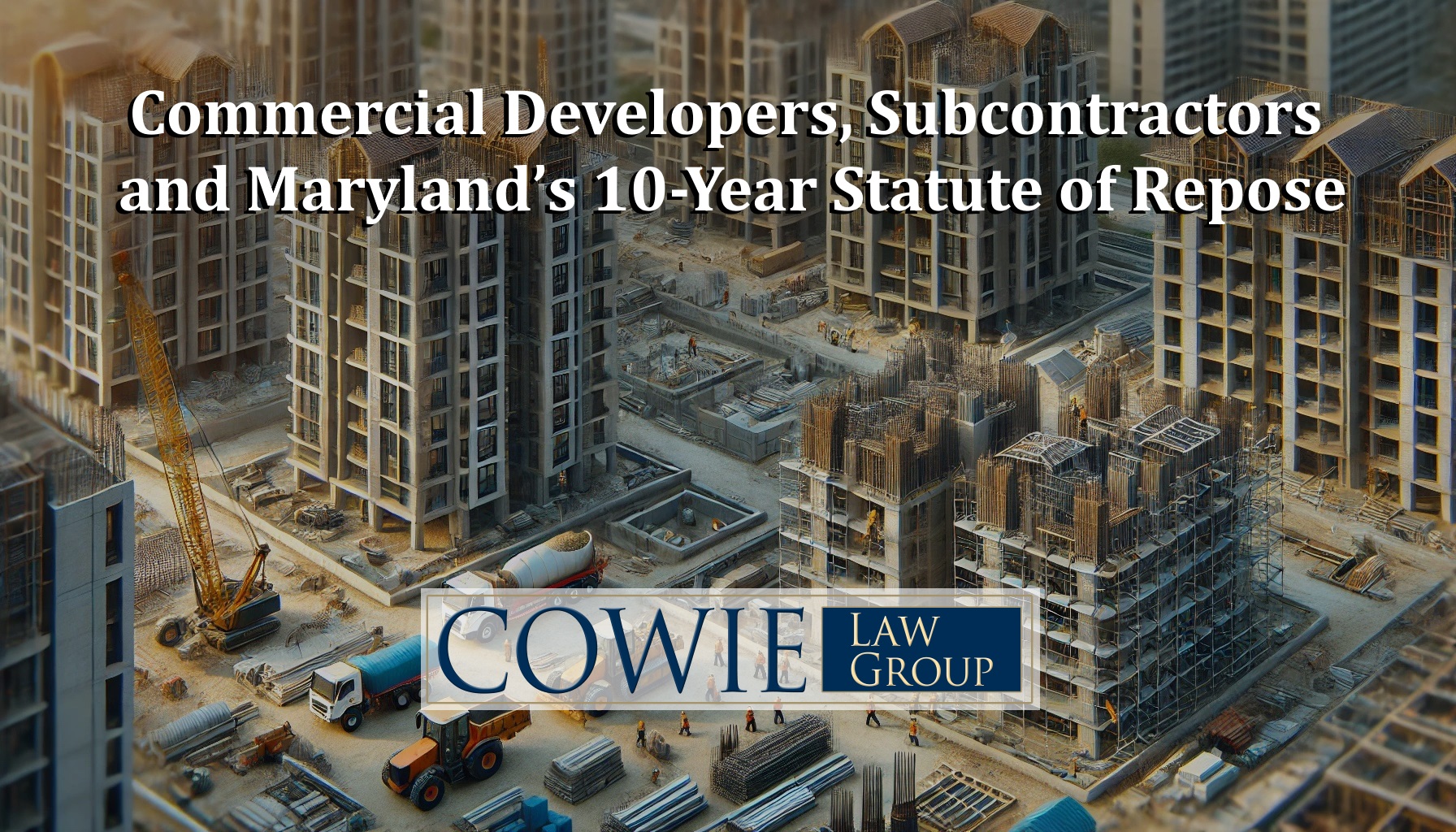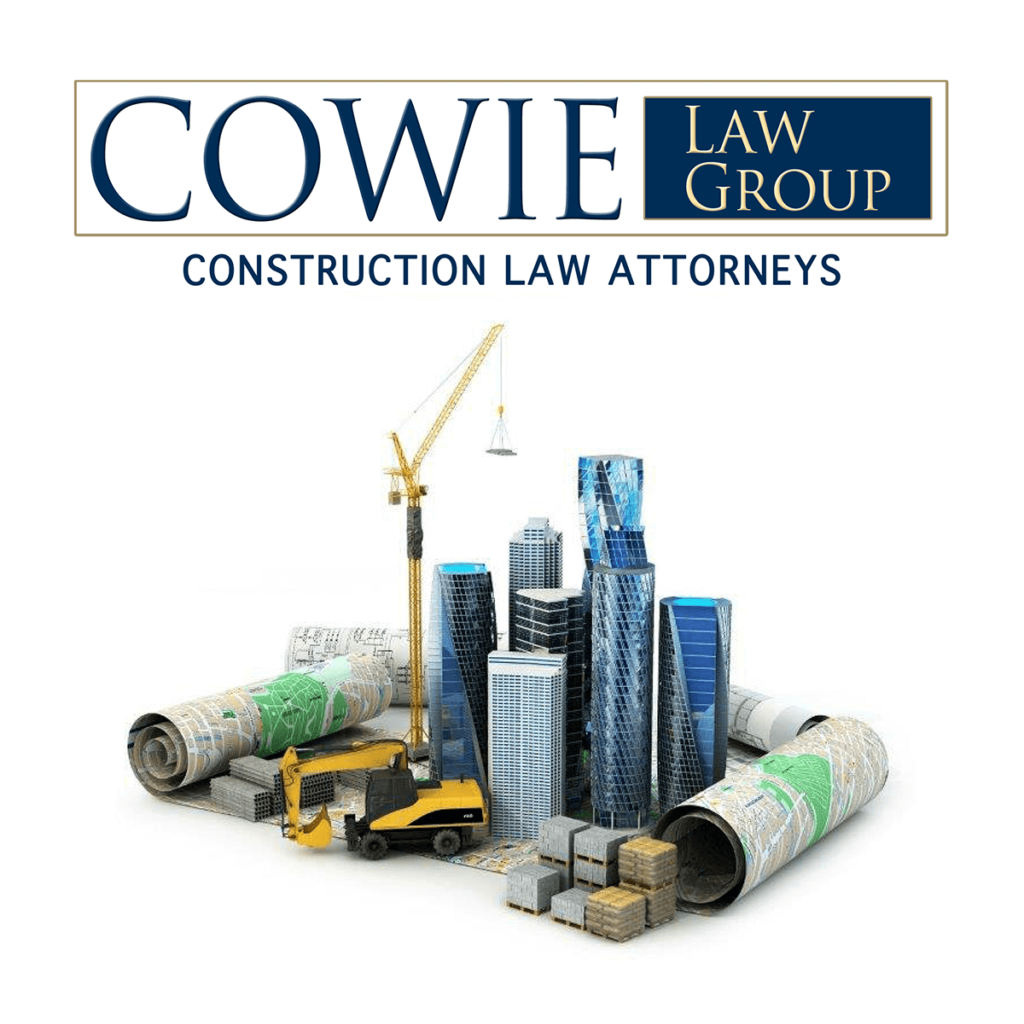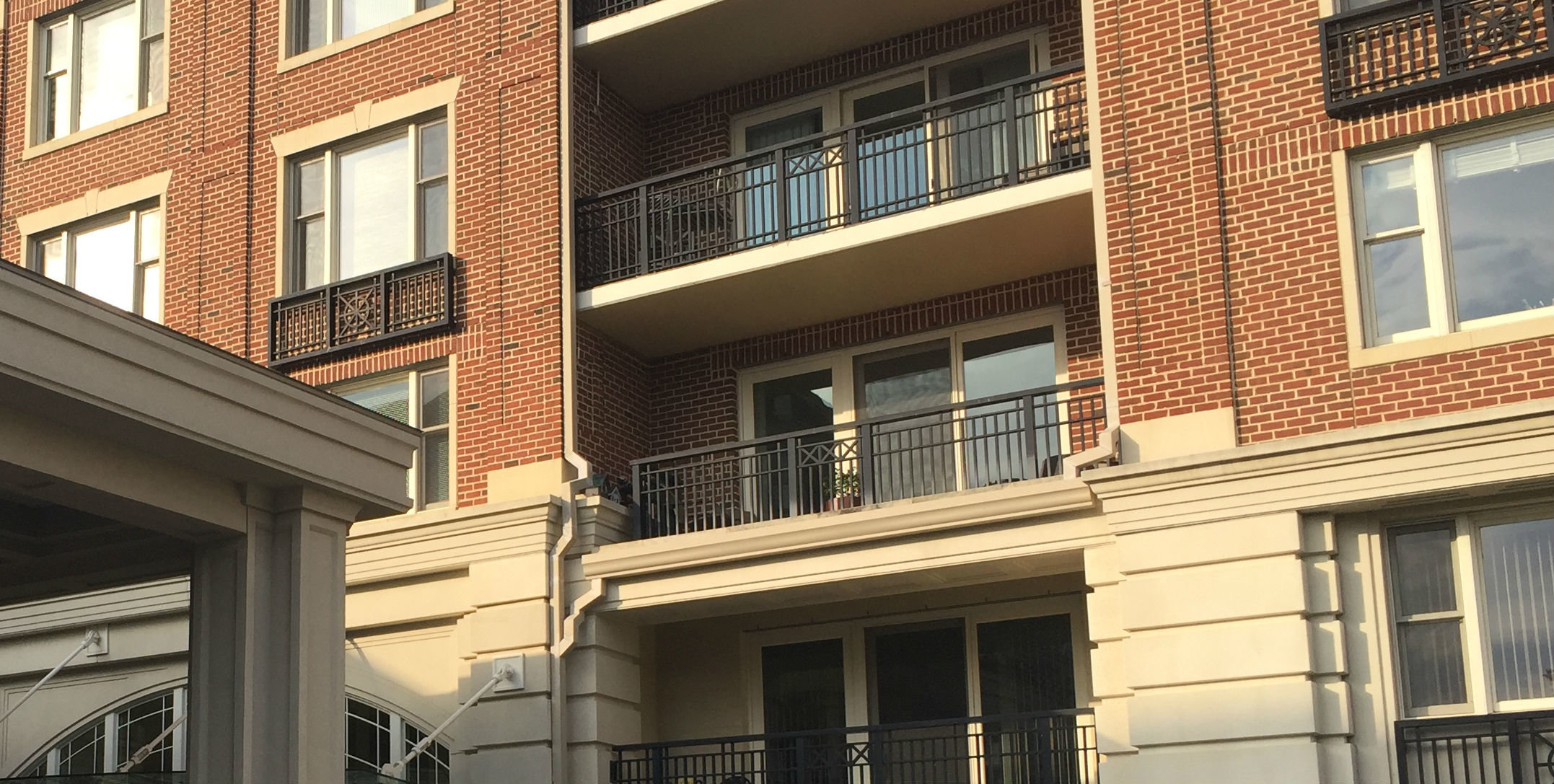
Are Commercial Developers and Subcontractors Protected from Defect Liability Claims Under Maryland’s 10-Year Contractor Statute of Repose?
This article examines Maryland’s 10-year statute of repose, Courts and Judicial Proceedings Article (“CJ”) §5-108(b), including how the statute works and whether it’s protections for “contractors” extend to commercial developers and subcontractors.
FederalCourts interpreting Maryland Law have address the issue of whether developers and subcontractors are protected. One court has held, in a non-binding opinion, that developers, unlike traditional general contractors, are not protected by the 10 years statute of repose. Another federal court has held that subcontractors are protected by the 10 year statute of repose to the same extent as “contractors.”
Maryland’s 20-Year Statue of Repose Distinguished
For clarity, this article refers to CJ §5-108(b) as the “10-year Contractor Statute of Repose” to distinguish it from Maryland’s broader 20-year statute of repose (CJ §5-108(a)) applicable to all construction defect claims, including claims against developers and subcontractors. The 20-year statute of repose applies whenever resulting property damage or personal injury occurs more than 20 years after construction is completed. This article, however, focuses on the Maryland’s 10-year Contractor Statute of Repose.
How Maryland’s 10-Year Contractor Statue of Repose Works in Relation to Construction Defect Claims
The 10-Year Contractor Statute of Repose bars construction defect legal claims (“causes of action”) against “any architect, professional engineer, or contractor” when the resulting injury to person or property for which damage is sought occurred more than 10 years after the completion of an “improvement to real property.”
The “completion” date is defined as “the date the entire improvement first became available for its intended use.” CJ §5-108(b).
An “improvement to real property” generally refers to buildings but may also include any permanent structure that is constructed on or added to real property, such as a parking lot, stormwater management pond or retaining wall. See, Craven v. Hickman, 135 Md. App. 645, 658 (2000).
It’s essence, the 10-Year Contractor Statute of Repose prevents certain claims from “accruing” under Maryland’s general 3-year statue limitations (CJ §5-101). Specifically, if the resulting injury occurs within the 10-year period, a legal cause of action against “any architect, professional engineer, or contractor,” to recover damages for the injury is not barred by the 10-Year Contractor Statute of Repose. As such, that cause of action can “accrue” and a lawsuit must be filed within 3 of the accrual date. On the other hand, if the resulting injury occurs after the 10-Year Period, a cause of action against “any architect, professional engineer, or contractor,” to recover damages for the injury does not accrue, and the claim is barred by the 10-Year Contractor Statute of Repose.
Example: If a commercial building sustained a severe water damage injury 15 years after it’s completion due to the installation of a defective sprinkler system, a construction defect or products liability claim against seeking compensation for the water damages against the contractor who installed the sprinkler system would be barred by the 10-Year Contractor Statute of Repose. On the other hand, if the water damage injury occurred within the 10 year period, the building owner would have 3 years to file a lawsuit.
Are Subcontractors Protected from Construction Defect Claims Under Maryland’s 10-Year Contractor Statue of Repose?
Subcontractors are protected from liability for construction defect claims under Maryland’s 10-year Contractor Statue of Repose. Although “subcontractors” are not specifically referenced in the statute, the Court of Appeals for the Fourth Circuit, interpreting Maryland law, has held that the term “contractors” is intended to include “subcontractors” who are hired by contractors to construct improvements to real property. Hartford Ins. Co. v. American Automatic Sprinkler, 201 F.3d 538 (4th Cir. 2000).
The Statute of Repose serves as a Cap on Delayed “Accrual of a Cause of Action” Under the Discovery Rule
To understand how the 10-year Contractor Statute of Repose applies to any given construction defect claim, it is essential to understand the concept of “accrual” of a cause of action under Maryland’s general 3-year statute of limitations (CJ §5–101). Maryland follows the “discovery rule” first adopted in the case of Poffenberger v. Risser, 290 Md. 631 (1981), under which a cause of action “accrues,” when plaintiff knew or should reasonably have known it has suffered an injury and its likely cause (“discovery”). Once accrual occurs, a plaintiff has three (3) years to bring a lawsuit under the general statute of limitations (CJ §5–101) and the Statute of Repose CJ §5–108(c).
In construction defect cases, delayed “accrual” of a latent defect is common. Construction defects in the structure of the building may remain hidden and undiscovered behind exterior walls or beneath floors. The effects of the defect may not to become known until resulting damage occurs many years after construction is complete. Maryland’s adoption of the discovery rule means that claims for construction defects can be brought well into the future, creating uncertainty for contractors. Maryland’s 10-year Contractor Statue of Repose (CJ §5–108(b)) is designed to protect contractors, architects, and engineers from extended liability by placing an outside limit on how long a cause of action against them is permitted to “accrue” under the discovery rule. Namely, there can be no accrual of a cause of action for damages against a contractor, architect or engineer when the property damage or personal injury caused by the construction defect occurs more than 10-years after completion of the buildings or other “improvement to real property” they design or construct:
“… a cause of action for damages does not accrue [against an] … architect, professional engineer, or contractor … when wrongful death, personal injury, or injury to real or personal property, resulting from the defective … condition of an improvement to real property… occurs more than 10 years after the date the entire improvement first became available for its intended use [emphasis added].”
CJ 5-108(b).
The date on which the resulting injury to person or property occurs is the crucial date for determining whether a construction defect cause of action will be permitted to accrue under the 10-year Contractor Statue of Repose. If the injury caused by a construction defect first occurs after the 10-year period, there can be no delayed accrual of a cause of action under the discovery rule.
On the other hand, if the injury caused by a construction defect first occurs within the 10-year period, a cause of action for damages against the responsible contractor can “accrue” under the discovery rule. In such a case, Maryland’s Statute of Repose specifies that the plaintiff has three (3) years to file suit from the date of accrual:
“Upon accrual of a cause of action referred to in subsections (a) and (b) of this section, an action shall be filed within 3 years.”
CJ §5-108(c). This statutory language confirms that claims for damage or injury occurring within the 10-year period, are subject to the general 3-year statute of limitations (CJ §5-101), which also provides 3 years to file suit from the date of accrual.
Filing Suit More Than After 10 Years After Completion of Construction
There is a common misconception that the 10-Year Contractor Statue of Repose prevents the filing of a construction defect lawsuit against a contractor more than 10 years after completion of a building. However, it is the date of the resulting injury, not the date a suit is filed, that is determinative. If the resulting injury to person or property occurs within the 10-year period, a plaintiff has 3-Years from accrual to file suit for damages against a contractor for construction defects under CJ § 5-108(b) and (c), even if the actual filing of that suit occurs more than 10 years after the completion of the building or other improvement.
Example: An overhead walkway in a hotel lobby collapse and injures a hotel guest on the last day of the 10-year period following completion of construction of the hotel. At this point, the injured hotel guest has three years to file suit against the contractor that constructed the defected defective walkway, meaning that suit could be filed up to 13 years after construction was completed (i.e., the 10-year statute of repose + 3-year statute of limitations = 13 years).
Are Developers Protected from Construction Defect Claims Under Maryland’s 10-Year Contractor Statue of Repose?
No Maryland appellate court has ruled on the issue of whether a developer is protected under the 10-year Contractor Statute of Repose. However, the U.S. District Court for the District of Maryland has ruled in an unreported opinion that the Maryland’s 10-Year Statute of Repose (CJ§ 5-108(b)) does not shield condominium developers from liability for condominium construction defect claims unless they act solely as contractors performing the construction work. See Council of Unit Owners of Milestone Townhouse Condos. v. Beazer Homes, LLC, No. GJH-18-1572, 2019 U.S. Dist. LEXIS 45914 (D. Md. Mar. 20, 2019) (the “Milestone”). Milestone is non-binding on Maryland courts; however, it may foreshadow how Maryland courts would rule on the issue.
In Milestone the Court found that developers’ ongoing responsibilities — selling homes and associated disclosure duties — make them fundamentally different from contractors. While a developer can also function as its own general contractor, the court held that this does not necessarily mean it is entitled to the statute of repose protections granted to “contractors.” The court noted that the developer Beazer not only supervised the construction of the condominium but also marketed and sold units to purchasers. Unlike a general contractor whose obligations typically end when construction is complete, a developer’s involvement often extends into post-construction sales and disclosures.
This rationale could be applied to a commercial developer who constructs a commercial building for itself and then continues to own the building period of time following construction before selling it to a third-party.
Exception to the Maryland’s Statue of Repose (both 10 and 20 year) for construction defect claims against Developers who Retain Possession and Control of an Improvement
There is an exception to Maryland’s 10-Year Contractor Statue of Repose for any person or entity, including developers and subcontractors, who are in possession and control of an improvement at the time,an injury to person or property occurs:
“ This section [i.e., the Statue of Repose] does not apply if …. [t]he defendant was in actual possession and control of the property as owner, tenant, or otherwise when the injury occurred;
CJ §5-108(d)(2)(i) This exception also applies to the broader 20-year statute of repose under CJ §5-108(a). In short, the Statue of Repose does not protect developers from construction defect claims or other dangerous conditions on property they are in possession and control of at the time an injury occurs:
The rationale for this exception is obvious. One who is in possession and control of a property has an ongoing duty for the maintenance, repair and upkeep the property. This duty includes exercising reasonable care to ensure that the property is not dangerous to those persons who foreseeably will be using the property, including tenants, guests, and other invitees. Developers who retained possession and control of properties they construct cannot rely on the 10-year or 20-year statue of repose as a defense to damages claim occurring more than 10 or 20 years after completion of construction. They remain subject to liability, just like any other property owner, for their own negligent construction or failure to maintain the property which results in a dangerous condition. The fact that they may have been a contractor for the property does not protect them.
Example: A developer plans and constructs a mobile home park, which involves installing plumbing to each of the mobile home lots with multiple underground compartments containing valves that control water supply. If a metal plate covering one of the underground compartments collapses due to a construction defect, injuring a Park resident, the Statute of repose would not bar a claim against the Park Owner for defective construction of the underground, plumbing compartments or for negligent failure to maintain the property.
Example: A developer who constructs a strip mall and retains ownership, leasing out spaces for retail purposes, would remain liable under the CJ §5-108(d)(2)(i) possession and control exception if a plaintiff injured on the property as a result of a construction defect roof collapse, no matter when the building was completed. The fact that the developer was also the contractor that built the strip mall for 20 years ago is irrelevant.
Conclusion
Maryland’s 10-Year Contractor Statute of Repose was designed to protect contractors, architects, and engineers from extended liability for delayed accrual of construction defect claims under the “discovery rule.” This includes protection for subcontractors, whose role in a construction project is like a contractor retained to perform a specific task with little or no involvement thereafter. However, the 10-year contractor statue of repose is not intended to protect developers who retain control of, sell, and market commercial properties. Such Developers’ ongoing responsibilities and relationship to the property, continuing beyond construction, arguably make many developers different from contractors and design professionals hired to perform a specific task on a developer property, after which their relationship to the property ends.
While Maryland appellate courts have not definitively ruled on this issue, the Milestone decision and the statutory language suggest that many developers should not receive protection under the 10-year Contractor Statute of Repose unless they can show their role was purely that of a contractor.
 410-327-3800 | 301-830-8315
410-327-3800 | 301-830-8315





